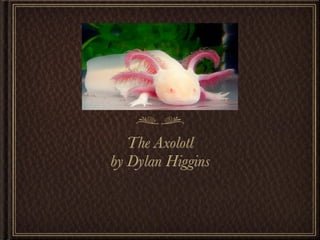
Dylankynoteaxolotl*2
- 1. The Axolotl by Dylan Higgins
- 2. Forever Young Like all species belonging to the amphibian group called salamanders, the Axolotl lays its eggs in fresh water and these hatch as larvae that obtain oxygen from the water using gills, develop, and feed on small plants and animals. Unlike its cousins however, the Axolotl does not undergo the change from aquatic to an air breathing life(metamorphosis). It remains forever young, growing up to 25 cm long, usually black in colour, and feeding on a variety of crustaceans, insect larvae, fish and molluscs.Whereas other amphibian species cannot reproduce in this non-metamorphosized state, the axolotl has no problem in doing so, becoming sexually mature in the larval form(a condition called “neotony”), with the females laying up to 1000 eggs each 3-6 months.
- 3. New limbs for old • Another incredible ability of the axolotl is its powers of regeneration. Not only can it reproduce a new limb or tail when these have been lost by accident or through attack by a predator, the axolotl can also regenerate brain and heart cells - a capacity that has attracted a great deal of interest in the medical world - and which all of us would dearly like to possess! One wonders what other valuable and amazing secrets this creature has yet to share.
- 4. What’s in a name The Spanish name “ajolote”, derives from the nahuatl “axolotl”, the name generally used outside Mexico. It means “water dog”, and describes an animal said to have been born when the Aztec god, Xolotl, fearing his immanent sacrifice, threw himself into the water and was transformed into the creature we see today. Perhaps there is some truth to this story because of the amazing, even god-like, powers that distinguish it from its fellow amphibians and other vertebrates.
- 5. The foundation of a nation? The axolotl was used by Aztecs in cerrmonies, as well as being consumed as food and medicine. It also believed that it was often traded, probably in exchange for building materials for the construction of Mexico City. So it might be said that the axolotl was instrumental in the building of the Mexican Nation. Even today some people still eat axolotls and they are used to produce medicine.
- 6. Critically endangered Despite its amazing biology, and the fact that the secret to its understanding might lie in the wild population in its remaining habitat, the rather tenuos futur of this population has been recognised in the species’ recent reclassification as “Critically endangered” by the IUCN. Hopefully, the efforts of the Mexican recearchers, conservationists, government and other people of Xochimilco will be able to work together to ensure its survival through appropriate and timely conservation planning and actions. Taxonomy - Ambystoma mexicanum’s place in the animal kingdom. Phylum: Chordata - animals with a hollow nerve chord running down their body. Subphylum: Vertebrata - animals with a bony ‘spine’ enclosing their nerve chord. Class: Amphibia: - four legged vertebrates (although some have become legless), adults usually air-breathing and mainly terrestrial, breeding in water, young are aquatic with gills. Order: Caudata (Urodela) - newts and salamanders - amphibians with short legs, a long trunk and a well-developed tail. Family: Ambystomatidae - a diverse group of 35 species of smooth-skinned, stoutly built salamanders found in North America.
- 7. THANK YOU FOR YOUR PATIENCE BY DYLAN HIGGINS ROOM 18